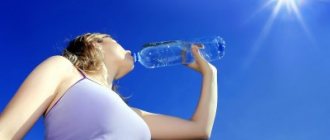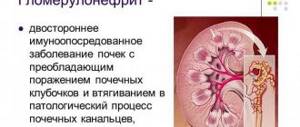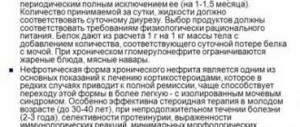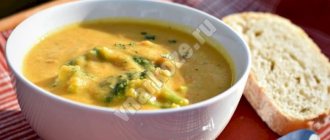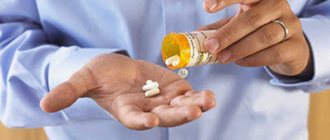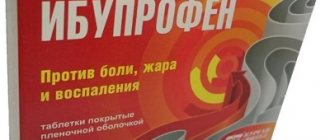Features of nutrition in glomerulonephritis
The presence of the disease leaves an imprint on the patient’s lifestyle, and above all on the nature of nutrition. Without a well-ordered diet, it is impossible to carry out full treatment. Find out more about the diet for kidney disease.
Nephrologists instruct patients in detail what can and cannot be eaten with glomerulonephritis. For kidney diseases, a therapeutic diet is prescribed, table 7.
Its general principle is to reduce or completely eliminate table salt from the diet. The daily norm should not exceed 6 g. The amount of free liquid is up to one liter per day. The amount of proteins and purines is reduced to a minimum, and the carbohydrate content is also reduced.
Salt is added to already prepared dishes (taking into account the doctor’s recommendations). Meat and fish are boiled so that extractive substances and salt are transferred into the broth.
The main methods of heat treatment of products are boiling in water or steaming and baking. Light frying is allowed. Dishes are served warm in small portions. Number of meals – 5-6
Features of the diet for glomerulonephritis contribute to the fact that in patients:
- the load on the kidneys is reduced,
- urination intensifies,
- metabolic processes in the kidney tissue are activated,
- tissue swelling decreases,
- blood flow improves,
- blood pressure is normalized,
- excess salts and under-oxidized metabolites are removed;
- the general condition of the body improves.
Diet 7 for glomerulonephritis is prescribed for a period determined by the doctor after a comprehensive examination of the patient. When preparing a diet, it is necessary to take into account other chronic diseases that the patient has and approach the selection of dishes individually. In this case, the recommendations may differ from the classic menu of table 7.
What can you eat on diet No. 7
The diet for kidney nephritis allows the following foods:
- boiled lean meat (poultry, beef, rabbit),
- boiled lean fish,
- salt-free unleavened or yeast baked goods (up to 250 g per day),
- eggs (up to 2 pieces per day),
- low-fat dairy and fermented milk products (except cheeses),
- vegetables (except those containing oxalic acid),
- berries and fruits in all types,
- low-carb desserts (jelly, soufflé, marmalade, jam, marmalade, honey),
- sugar (up to 50 g per day),
- freshly squeezed juices, diluted 1:1 with water,
- porridge (rice, oatmeal, barley, pearl barley, corn, buckwheat, wheat),
- durum wheat pasta,
- mild sauces,
- unsalted butter, refined vegetable oil (for frying or adding to prepared dishes),
- weak tea, herbal infusions, compote, weak coffee with milk, rosehip infusion, unsalted and still water.
Cinnamon, vanillin and apple cider vinegar are allowed in limited quantities.
What not to eat
Patients diagnosed with glomerulonerphritis will have to refrain from:
- smoked meat and fish,
- sausages,
- cheeses,
- pickles and preserves,
- fast food and semi-finished products,
- mushrooms,
- broths,
- hot seasonings,
- beans, sorrel, spinach, radish, radish, celery, parsnip, parsley, onion, garlic,
- fatty meat and fish,
- confectionery products containing soda and butter cream,
- salty bread
- margarine, shortening, salted butter,
- hot seasonings and sauces (mayonnaise, mustard, adjika)
- strong tea and coffee,
- desserts containing cocoa and chocolate,
- ice cream,
- sodium mineral water,
- soda,
- alcoholic drinks and energy drinks.
Diet features
The main purpose of a special table for patients with glomerulonephritis is to reduce the load on the kidneys. For this purpose, fried, salted, smoked, hot and spicy foods are prohibited. As you recover, something from the forbidden list can be included in the diet. This is determined by the attending physician and establishes the permissible amount of a particular product.
In addition to reducing the load on the kidneys, eating specially prepared foods is designed to reduce swelling in the body and eliminate hypertension, which is quite possible with this disease.
Nutrition for acute glomerulonephritis
According to the nature of the course, acute (several weeks), subacute (several months) and chronic (several years) glomerulonephritis is distinguished. Under certain conditions, chronic glomerulonephritis can also progress to the acute stage.
The diet for acute glomerulonephritis should be aimed at reducing the daily calorie intake by reducing fats and carbohydrates and increasing protein intake. To do this, it is necessary to limit fluid intake and eliminate foods that irritate the kidneys.
Diet in the acute stage of chronic glomerulonephritis involves the same measures as in primary acute glomerulonephritis.
In the first three days of an exacerbation, it is recommended to consume watermelon pulp and avoid salty foods. A sodium-free sugar-fruit diet is recommended. You can eat boiled jacket potatoes, apples, grapes, kefir.
Then they switch to a salt-free dairy-vegetable diet. Include milk, cottage cheese, fish, and egg whites in the diet.
During recovery, meat dishes are added to the menu. But the amount of protein should not exceed 90 g per day. The diet for acute glomerulonephritis involves limiting salt intake. This low-salt diet must be followed for at least three months.
Meals should be fractional (4-5 times a day), and portions should be small. The total energy value of food per day should not exceed 2100 kcal.
Dietary recipes for kidney diseases
There is a certain way of preparing products that can be consumed not only by patients with glomerulonephritis, but also by patients suffering from any kidney diseases.
Steamed beef cutlets with fish
Cut the beef pulp and pike perch fillet into pieces. Cool and pass it all through a meat grinder. Add butter, potato starch, eggs and milk to the minced meat. Add salt and beat all these ingredients well.
Doctors recommend dietary table No. 7
Form cutlets and steam them. For one serving - two cutlets.
Steam omelette with meat
Eggs, milk, beef and butter are used. The meat pulp is cooked until tender, then, after removing the tendons, it is passed through a meat grinder. The eggs are beaten and mixed with milk.
Mix meat and egg with milk, add salt to taste and steam.
Potatoes baked with cheese
Input products: potatoes, milk, hard cheese and butter. The potatoes need to be washed, peeled and cut into thin slices. Slice the cheese.
Grease the pan with butter and layer the potatoes and cheese, alternating between them. Place a few pieces of butter on each layer of cheese.
Pour milk over the entire dish, place in the oven and bake for an hour. It is recommended to remove the lid 20 minutes in advance so that the potatoes acquire a beautiful color.
Nutrition for chronic glomerulonephritis
The diet for chronic glomerulonephritis involves reducing salt and protein intake. In addition, you should avoid spices, meat and fish broths.
Particular attention should be paid to protein foods, vegetables, fruits and dairy products. You should definitely include potatoes, eggs (white), and soy in your menu.
You will have to exclude cheese, egg yolk, legumes, nuts, and cocoa from your diet. The amount of fluid you drink per day should exceed the amount excreted from the body by no more than 500 mg.
As in the acute stage of the disease, it is necessary to eat in small portions and adhere to fractional meals (5 times). In case of chronic glomerulonephritis, the caloric content of consumed foods is limited and a diet with a daily calorie content of no more than 3000 kcal is prescribed.
Basic principles
Nutrition for glomerulonephritis is based on the following principles:
- In the acute form of the disease, the caloric content of the diet is up to 2200 kcal. In this case, you need to consume 20 g of protein, 80 g of fat, 350 g of carbohydrates and no more than two grams of sodium chloride. Dishes are prepared without salt. You can boil them, bake them, fry them a little. It is recommended to eat up to six times a day.
- In case of chronic glomerulonephritis, after discharge from the hospital, you need to adhere to a caloric intake of 3200 kcal. 50 g of protein, 90 g of fat, 450 g of carbohydrates and 8 grams of salt are consumed per day. You need to eat at least five times a day in small portions.
- The required amount of fluid is determined by its daily allocation. You are allowed to drink weak tea, fresh fruit and vegetable juices, and rosehip infusion.
- Protein is limited in the diet. It is usually calculated according to the formula up to 1 g per kilogram of the patient’s weight, and the proportion of animal protein was no more than 50%.
- The diet includes foods containing a lot of potassium, a component responsible for the removal of fluid. These include, for example, baked potatoes.
Features of nutrition of children with glomerulonephritis
The diet for glomerulonephritis in children depends on the characteristics of the disease. In the acute stage, the consumption of salt, animal proteins and liquids is strictly limited. As the condition improves, the menu expands by adding milk, dairy products, eggs, and wheat bread.
A child with chronic nephritis in remission is prescribed a predominantly dairy-vegetable diet: cereals, potatoes, fruits, vegetables, juices, jam, marmalade
You also need:
- exclude allergens, smoked foods, strawberries, as well as meat and fish from the diet,
- consume more foods containing potassium (raisins, bananas, potatoes),
- do not exceed the daily calorie content of 2700 kcal.
Permitted and prohibited products
The diet is based on the following products:
- Bread . Salt-free flour products are allowed. Plain bread and baked goods containing salt are prohibited.
- Lean meat and fish . Chicken, rabbit, turkey, veal, pork, beef are allowed. It is important to follow the norm - this is 50-60 grams. Seafood is not allowed.
- Vegetable soups . It is important that they fit into the fluid norm.
- Eggs (half or quarter per day).
- Dairy products : sour cream, cream, milk - up to 60 grams.
- Cereals : rice, sago, protein-free pasta. Other cereals, pasta, and legumes are prohibited.
- Vegetables . Everything except cabbage, radish, legumes, sorrel, garlic, mushrooms, spinach. Pickled and pickled vegetables are also not allowed.
- Fruits and berries . They can be eaten dried and baked, or made into jellies, fruit drinks, and compotes.
- For sweets, you can eat honey, jam, sugar, and candies (without chocolate) in moderation.
- Spices : dishes can be supplemented with sour cream, cinnamon, vanillin, citric acid, tomato paste, boiled onions.
- Sources of fats are vegetable oils, unsalted butter, baked cow's milk. Other fats are prohibited.
- Drinks allowed include fruit and berry juices, rosehip decoction, and herbal tea. Coffee, cocoa, carbonated drinks are prohibited.
Certain foods can have a negative impact on the course of the disease and aggravate it, leading to kidney failure.
The following categories of products are prohibited:
- fatty food;
- smoked;
- everything canned;
- spicy dishes;
- alcoholic drinks.
Sample menu for the day
Drawing up a daily diet is a purely individual matter. It is necessary to conduct a comprehensive examination of the patient, taking into account the characteristics of his body and food preferences.
A tentative menu for the day might look like this:
- Breakfast: steamed vegetable cutlets, a cup of weak tea.
- Second breakfast: fruits (from the list of permitted ones),
- Lunch: vegetable soup, stewed lean meat, baked or boiled potatoes, fruit juice (fruit juice).
- Afternoon snack: A glass of rosehip infusion or herbal tea.
- Dinner: porridge with water, vegetable salad with sunflower or olive oil, herbal tea.
- An hour before bedtime: a glass of kefir or fruit juice.
Recommendations for the duration of compliance
Additionally, experts give the following recommendations:
- The ingredients must be cooked. You can boil or steam food.
- Include foods high in vitamin C in your diet - this will increase the body's defenses and help it fight the disease.
- Monitor the protein content in the urine, blood composition, and the amount of urine excreted.
- If a child has glomerulonephritis, he is also prescribed a special diet, which involves the exclusion of salty, smoked, canned foods, food that contains dyes, stabilizers, soda, and sweets. You can diversify your child’s menu with vegetables, fruits, berries, jelly, and fruit drinks.
Glomerulonephritis is not a death sentence
Advanced glomerulonephritis leads to severe complications. To combat illness, proper nutrition alone is not enough. It is necessary to take medications prescribed by the nephrologist. But you shouldn’t rely solely on medications.
Only a comprehensive fight against the disease, including avoiding prohibited foods, following a daily routine, following doctor’s recommendations and taking medications in a timely manner, will help overcome the disease and give the patient the opportunity to lead a full life.
